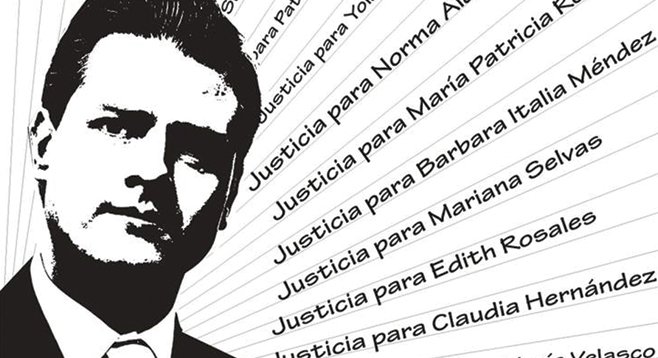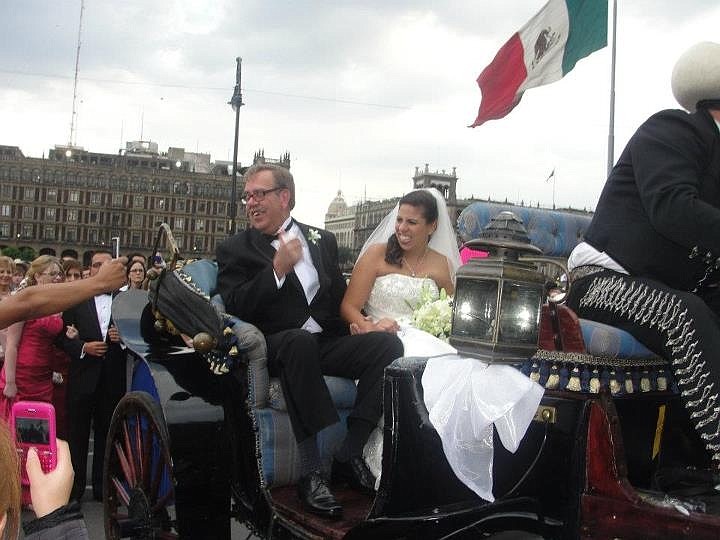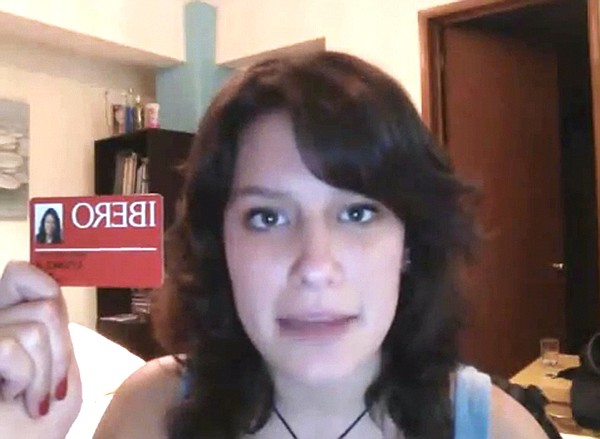 Facebook
Facebook
 X
X
 Instagram
Instagram
 TikTok
TikTok
 Youtube
Youtube

Mexico: Between Dinosaurs and the Power of the #
Mariana always wanted to get married at the Metropolitan Cathedral in Mexico City. When the time came, she decided to make her dream come true: her ceremony would be at the historic church in the Zocalo, the central plaza of the entire country. Her other dream was to arrive to the church in a horse-drawn carriage.

Everything to the tiniest detail was planned, but she wasn’t counting on her wedding day coinciding with a student movement named #yosoy132 — a monumental street protest against the virtual winner of the Mexican election, Enrique Peña Nieto in the Zocalo. That day the space in front of the church was an ocean of people; it was impossible to walk or move, much less travel in a carriage pulled by horses. But Mariana was determined to go through with her plan. She got in the coach and said to the driver, “Let’s go.” Mariana’s driver didn’t know what to do. It was impossible to move. He knew it was madness, but he took a deep breath and he yelled, “Make way for the movement’s bride!” Mariana stood up, raised her bouquet and shouted, “¡Fuera, Peña Nieto!” (“Get rid of Enrique Peña Nieto!”) The multitude responded, “¡Fuera!” and suddenly the sea of people parted to let the bride pass through to the cathedral. In between the anti–Peña Nieto slogans, they shouted, “Long live the Movement’s bride.”
At the same moment, the most important cities of Mexico were hosting similar scenes, minus the bride, of course. Even in Tijuana, which is not a city for activists (one could say it is definitely not a place where civilian movements bloom), for the first time in history all sorts of people joined the national protest: students, mothers and their kids, dogs in strollers, factory workers, young men in suits, old folks in wheelchairs, punk rockers, writers, college girls with flowers, artists, and photographers.
The #yosoy132 movement seed began to germinate on the morning of May, 11, when the ex-governor and then presidential candidate Enrique Peña Nieto was invited to speak in front of students at the Universidad Iberoamericana, a private Jesuit college in Mexico City. At the end of his talk, Peña Nieto gave an unfortunate speech, accepting full responsibility during his term as governor in the repression of the Atenco farmers (where many detainees were tortured, at least 26 women were raped by the police, and two people were killed, one of them a 14-year-old boy).
The response of the students was furious and immediate, as they booed Peña Nieto, calling him a coward and a murderer. When he tried to leave, he was chased all around the campus. The students formed a choir and chanted: “Enrique, listen, Ibero doesn’t want you.” The candidate’s confident image was shattered. Cell phones recorded and photographed him trying to run away. Ultimately, he had to hide for 20 minutes in an underground restroom. As he hid, the videos of the protest were already being uploaded to YouTube; they went viral immediately. At risk was a very long and expensive political campaign sowed by the PRI (Revolutionary Institutional Party) with the objective of regaining political power for the first time in 12 years.

The Ibero protest might have ended up an isolated event, but thanks to the PRI’s arrogance it turned into a national movement. Before I go into details, allow me to say why the Ibero incident was so important: in Mexico there is a tradition of student activism that goes back to the 1960s, but it mainly comes from public universities. Activist students are usually working-class and often they are transparently left-wingers, so whenever there’s any sign of political agitation among students they are promptly despised (if not violently repressed, like the student massacre in 1968).
On the other hand, Ibero students have often been stigmatized as wealthy kids from the Mexican upper class who live in a world apart from the rest of Mexico’s society (which, by the way, is very classist). There’s even a nickname for them: “Chico Ibero,” a term coined to identify a student who is rich and clueless. In a society ruled by stereotypes, it was unimaginable that these privileged kids would call Peña Nieto a murderer.
Right after the Ibero incident, the PRI and its paid lackey, the Partido Verde (Green Party), mocked the students by insinuating that the protesters were just a few trained infiltrators and not Ibero students. This became the news, rather than the actual protest because Televisa and TV Azteca (the two national television networks that control most of the TV channels and newscasts of the country) functioned as Peña Nieto’s paid spokespeople. Futile attempts to block information were made; for example, the day after the protest, 31 of the newspapers that belong to the Organización Editorial Mexicana (which is the largest newspaper company in Latin America) had the same headline: Peña Nieto Triumphs at the Ibero Despite an Orchestrated Boycott Attempt.
The good news was YouTube showed a different story. The only place to find information useful to form an independent opinion was its source: the students and their Twitter feeds, Facebook, and YouTube accounts. Soon, a few independent anchors, such as Carmen Aristegui, and some foreign periodicals and independent newspapers began to broadcast a more balanced point of view.

In response to the PRI’s allegations, 131 students who were at Peña Nieto’s talk at the Ibero made a video in which they stated they were at the protest and were not trained or manipulated by anyone. Each one of them stated their name, their student account number, and showed their Ibero student-identity card. It was a simple but powerful act that showed tremendous courage; they were not hiding in anonymity and were not afraid of political prosecution. The students annihilated the “Chico Ibero” stereotype at once, and they demonstrated that even the privileged class opposed the return of the PRI; perhaps most importantly, they represented a free voice in an overwhelming barrage of pro–Peña Nieto information published on mass media. The 131 Ibero students’ video immediately went viral.
In support of those 131 students from Ibero, Twitter users started two hashtags: #masde131 (more than 131) and #yosoy132 (I am 132), the last one became the name of an unprecedented civilian movement that demanded clarity in the elections. Intellectuals, artists, concerned citizens, farmers, students from all sorts of backgrounds joined #yosoy132 and used it as a symbol that showed they were against the comeback of PRI, they didn’t want Peña Nieto, they demanded free media, they wanted voters to be free and informed, they were against electoral fraud, they wanted a real democracy. Civil organization started and there were national street protests before and after the election.
The Perfect Dictatorship
The Mexican political system is chaotic and complex. Both superficially and officially, it appears to be a democracy, but once you scratch the surface, that veneer comes right off.
In 1990, Peruvian writer Mario Vargas Llosa called Mexico “the perfect dictatorship.” He was giving a talk alongside other intellectuals, and he made a remark on the tradition of military dictatorships throughout Latin America. In contrast, Mexico was never under a military regime but was governed solely by the Partido Revolucionario Institucional (PRI). For almost 80 years it was unimaginable that there could be anyone in office that came from any other political party. During most of that time, all of the presidents, the majority of the congress, and all of the governors came from PRI (though there were rare exceptions: in 1989 the PAN won Baja California, the first Mexican state that had a governor that was not from PRI in 60 years).
The president of Mexico was omnipotent: all the laws he proposed passed automatically; it was he who decided who would be the next PRI presidential candidate and, thus, the next president. Popularly, the candidate was called the “tapado” (the one who’s covered) and the procedure by which he chose the next candidate was called the “dedazo” (the pointing of finger). Workers’ unions, mass media, and institutions were nothing but the PRI’s instruments of power. It was an oligarchy in disguise. The rest of the political parties were mainly budgetary leeches that provided validation to democracia à la Mexicana. The absolute domination of the PRI in Mexico produced a strong system of corruption and nepotism. The government was a huge máquina de la mordida (bribery machine) that would not give up political power under any circumstance. Fraud was a common practice and the vote was a mere formality to stay in line with the national constitution.
In 1986 a democratic fraction of the PRI parted and founded the National Democratic Front. In 1988, the FND ran Cuauhtémoc Cárdenas (son of Lázaro Cárdenas, a former president of Mexico) as presidential candidate against Carlos Salinas De Gortari. Cuauhtémoc Cárdenas won, but the PRI changed the results on the night of the election, making Salinas president. (The fraud was ultimately admitted to the New York Times by Miguel de la Madrid, who was president at the time.) After the election, the FDN became Partido de la Revolución Democrática (PRD). Cuauhtémoc Cárdenas ran for office two more times but was never able to repeat the 1988 achievement.
In the ensuing years, the PRD grew and gained seats in congress and several states and became the dominant political force in Mexico City. The PAN also grew, up to the point that in 2000, Vicente Fox became the first president of Mexico who did not come from the PRI. Six years after, the PAN’s Felipe Calderón ran against Andrés Manuel López Obrador (PRD) and Roberto Madrazo (PRI). Calderón and López Obrador were in a virtual tie but the Instituto Federal Electoral (IFE) declared Calderón winner (even though Calderón was barely 0.58 percent ahead of López Obrador) and no recount of the votes was allowed. Again, the word fraud floated in the air.

After losing two consecutive presidential elections and being relegated to third place in the last one, the PRI gathered all its forces and began to campaign for Enrique Peña Nieto years before the official campaign period started. The ex-governor was groomed and packaged until he became a mass-consumption product with moussed hair and a beautiful soap-opera-actress wife, La Gaviota (the seagull). Peña Nieto popped up in socialite magazines, tabloids; he had a fan club; he was Elvis, minus the talent but with screaming hordes of female fans. At conventions, the PRI gave away Peña Nieto dolls. He was green-washed and promoted as the Partido Verde candidate (the Verde formed an alliance with PRI).
But there were details that didn’t quite fit. Peña Nieto’s speech was superficial, there was no depth of thought, he used a teleprompter, and he got in trouble whenever he had to speak without help. There are colorful and infamous anecdotes about his verbal clumsiness, such as when Peña Nieto was at a book fair and he could not name three books he had read; and the time when he could not say how his first wife died.
But the most important and questionable feature of the candidate was that he belonged to the Grupo Atlacomulco, which is a deeply corrupt side of the PRI (the politicians that belong to this group are old-guard priístas, and popularly they are called dinosaurios). This stirred up suspicions of Peña Nieto being the puppet of the darkest and most retrograde elements of the PRI.
The Aftermath of a Controversial Election
The year 2012 is bringing forth watershed moments in the construction of democracy in Mexico. Before the eruption of the students in the political arena, the presidential election was dull. It was just the same sad story, with its share of intrigue and mass murder, suitcases full of cash, rampant poverty, and behind-the-scenes political warfare.
Thanks to the civilian movement, Mexican citizens observed this election. A huge number of irregularities were found. The PRI went back to its tradition of fraudulent practices. Before the election, two million duplicated ballots were found in Oaxaca. Low-income citizens were paid in food, cash, and store credit if they voted PRI (technology was used to prove how citizens voted: they had to show cell-phone photos of their ballot in order to receive payment). There were voting polls where 110 percent on the population voted. Even the dead voted. In PRI-ruled states, citizens were promised their taxes and fines would be pardoned if they voted PRI. PRI agents purchased voting cards from citizens. Strong-arm tactics were used so citizens would vote PRI. On the Preliminary Vote Electronic Reporting System (PREP), the votes for López Obrador disappeared or were reported “illegible,” but votes for the rest of the parties were fine. Electoral urns full of votes were stolen.
On the night of the election, Peña Nieto was declared winner with only 5 percent of the votes counted. The rest of the candidates declared him winner; even Calderon declared him winner. Andrés Manuel López Obrador made no comment about the results. The Mexican public was in shock: while international news declared the election was “too close to call,” in Mexican news, Peña Nieto was declared the absolute winner.
The gravest thing about these elections is that the PRI relied on the extreme poverty of underprivileged Mexican citizens in order to win. History has proven that the PRI only produces more poor and uninformed citizens, who sell off their votes for the tiniest of gifts in exchange for their loyalty. It’s an endless cycle that can only be broken with information, education, and a lot of hard work.


Mexico: Between Dinosaurs and the Power of the #
Mariana always wanted to get married at the Metropolitan Cathedral in Mexico City. When the time came, she decided to make her dream come true: her ceremony would be at the historic church in the Zocalo, the central plaza of the entire country. Her other dream was to arrive to the church in a horse-drawn carriage.

Everything to the tiniest detail was planned, but she wasn’t counting on her wedding day coinciding with a student movement named #yosoy132 — a monumental street protest against the virtual winner of the Mexican election, Enrique Peña Nieto in the Zocalo. That day the space in front of the church was an ocean of people; it was impossible to walk or move, much less travel in a carriage pulled by horses. But Mariana was determined to go through with her plan. She got in the coach and said to the driver, “Let’s go.” Mariana’s driver didn’t know what to do. It was impossible to move. He knew it was madness, but he took a deep breath and he yelled, “Make way for the movement’s bride!” Mariana stood up, raised her bouquet and shouted, “¡Fuera, Peña Nieto!” (“Get rid of Enrique Peña Nieto!”) The multitude responded, “¡Fuera!” and suddenly the sea of people parted to let the bride pass through to the cathedral. In between the anti–Peña Nieto slogans, they shouted, “Long live the Movement’s bride.”
At the same moment, the most important cities of Mexico were hosting similar scenes, minus the bride, of course. Even in Tijuana, which is not a city for activists (one could say it is definitely not a place where civilian movements bloom), for the first time in history all sorts of people joined the national protest: students, mothers and their kids, dogs in strollers, factory workers, young men in suits, old folks in wheelchairs, punk rockers, writers, college girls with flowers, artists, and photographers.
The #yosoy132 movement seed began to germinate on the morning of May, 11, when the ex-governor and then presidential candidate Enrique Peña Nieto was invited to speak in front of students at the Universidad Iberoamericana, a private Jesuit college in Mexico City. At the end of his talk, Peña Nieto gave an unfortunate speech, accepting full responsibility during his term as governor in the repression of the Atenco farmers (where many detainees were tortured, at least 26 women were raped by the police, and two people were killed, one of them a 14-year-old boy).
The response of the students was furious and immediate, as they booed Peña Nieto, calling him a coward and a murderer. When he tried to leave, he was chased all around the campus. The students formed a choir and chanted: “Enrique, listen, Ibero doesn’t want you.” The candidate’s confident image was shattered. Cell phones recorded and photographed him trying to run away. Ultimately, he had to hide for 20 minutes in an underground restroom. As he hid, the videos of the protest were already being uploaded to YouTube; they went viral immediately. At risk was a very long and expensive political campaign sowed by the PRI (Revolutionary Institutional Party) with the objective of regaining political power for the first time in 12 years.

The Ibero protest might have ended up an isolated event, but thanks to the PRI’s arrogance it turned into a national movement. Before I go into details, allow me to say why the Ibero incident was so important: in Mexico there is a tradition of student activism that goes back to the 1960s, but it mainly comes from public universities. Activist students are usually working-class and often they are transparently left-wingers, so whenever there’s any sign of political agitation among students they are promptly despised (if not violently repressed, like the student massacre in 1968).
On the other hand, Ibero students have often been stigmatized as wealthy kids from the Mexican upper class who live in a world apart from the rest of Mexico’s society (which, by the way, is very classist). There’s even a nickname for them: “Chico Ibero,” a term coined to identify a student who is rich and clueless. In a society ruled by stereotypes, it was unimaginable that these privileged kids would call Peña Nieto a murderer.
Right after the Ibero incident, the PRI and its paid lackey, the Partido Verde (Green Party), mocked the students by insinuating that the protesters were just a few trained infiltrators and not Ibero students. This became the news, rather than the actual protest because Televisa and TV Azteca (the two national television networks that control most of the TV channels and newscasts of the country) functioned as Peña Nieto’s paid spokespeople. Futile attempts to block information were made; for example, the day after the protest, 31 of the newspapers that belong to the Organización Editorial Mexicana (which is the largest newspaper company in Latin America) had the same headline: Peña Nieto Triumphs at the Ibero Despite an Orchestrated Boycott Attempt.
The good news was YouTube showed a different story. The only place to find information useful to form an independent opinion was its source: the students and their Twitter feeds, Facebook, and YouTube accounts. Soon, a few independent anchors, such as Carmen Aristegui, and some foreign periodicals and independent newspapers began to broadcast a more balanced point of view.

In response to the PRI’s allegations, 131 students who were at Peña Nieto’s talk at the Ibero made a video in which they stated they were at the protest and were not trained or manipulated by anyone. Each one of them stated their name, their student account number, and showed their Ibero student-identity card. It was a simple but powerful act that showed tremendous courage; they were not hiding in anonymity and were not afraid of political prosecution. The students annihilated the “Chico Ibero” stereotype at once, and they demonstrated that even the privileged class opposed the return of the PRI; perhaps most importantly, they represented a free voice in an overwhelming barrage of pro–Peña Nieto information published on mass media. The 131 Ibero students’ video immediately went viral.
In support of those 131 students from Ibero, Twitter users started two hashtags: #masde131 (more than 131) and #yosoy132 (I am 132), the last one became the name of an unprecedented civilian movement that demanded clarity in the elections. Intellectuals, artists, concerned citizens, farmers, students from all sorts of backgrounds joined #yosoy132 and used it as a symbol that showed they were against the comeback of PRI, they didn’t want Peña Nieto, they demanded free media, they wanted voters to be free and informed, they were against electoral fraud, they wanted a real democracy. Civil organization started and there were national street protests before and after the election.
The Perfect Dictatorship
The Mexican political system is chaotic and complex. Both superficially and officially, it appears to be a democracy, but once you scratch the surface, that veneer comes right off.
In 1990, Peruvian writer Mario Vargas Llosa called Mexico “the perfect dictatorship.” He was giving a talk alongside other intellectuals, and he made a remark on the tradition of military dictatorships throughout Latin America. In contrast, Mexico was never under a military regime but was governed solely by the Partido Revolucionario Institucional (PRI). For almost 80 years it was unimaginable that there could be anyone in office that came from any other political party. During most of that time, all of the presidents, the majority of the congress, and all of the governors came from PRI (though there were rare exceptions: in 1989 the PAN won Baja California, the first Mexican state that had a governor that was not from PRI in 60 years).
The president of Mexico was omnipotent: all the laws he proposed passed automatically; it was he who decided who would be the next PRI presidential candidate and, thus, the next president. Popularly, the candidate was called the “tapado” (the one who’s covered) and the procedure by which he chose the next candidate was called the “dedazo” (the pointing of finger). Workers’ unions, mass media, and institutions were nothing but the PRI’s instruments of power. It was an oligarchy in disguise. The rest of the political parties were mainly budgetary leeches that provided validation to democracia à la Mexicana. The absolute domination of the PRI in Mexico produced a strong system of corruption and nepotism. The government was a huge máquina de la mordida (bribery machine) that would not give up political power under any circumstance. Fraud was a common practice and the vote was a mere formality to stay in line with the national constitution.
In 1986 a democratic fraction of the PRI parted and founded the National Democratic Front. In 1988, the FND ran Cuauhtémoc Cárdenas (son of Lázaro Cárdenas, a former president of Mexico) as presidential candidate against Carlos Salinas De Gortari. Cuauhtémoc Cárdenas won, but the PRI changed the results on the night of the election, making Salinas president. (The fraud was ultimately admitted to the New York Times by Miguel de la Madrid, who was president at the time.) After the election, the FDN became Partido de la Revolución Democrática (PRD). Cuauhtémoc Cárdenas ran for office two more times but was never able to repeat the 1988 achievement.
In the ensuing years, the PRD grew and gained seats in congress and several states and became the dominant political force in Mexico City. The PAN also grew, up to the point that in 2000, Vicente Fox became the first president of Mexico who did not come from the PRI. Six years after, the PAN’s Felipe Calderón ran against Andrés Manuel López Obrador (PRD) and Roberto Madrazo (PRI). Calderón and López Obrador were in a virtual tie but the Instituto Federal Electoral (IFE) declared Calderón winner (even though Calderón was barely 0.58 percent ahead of López Obrador) and no recount of the votes was allowed. Again, the word fraud floated in the air.

After losing two consecutive presidential elections and being relegated to third place in the last one, the PRI gathered all its forces and began to campaign for Enrique Peña Nieto years before the official campaign period started. The ex-governor was groomed and packaged until he became a mass-consumption product with moussed hair and a beautiful soap-opera-actress wife, La Gaviota (the seagull). Peña Nieto popped up in socialite magazines, tabloids; he had a fan club; he was Elvis, minus the talent but with screaming hordes of female fans. At conventions, the PRI gave away Peña Nieto dolls. He was green-washed and promoted as the Partido Verde candidate (the Verde formed an alliance with PRI).
But there were details that didn’t quite fit. Peña Nieto’s speech was superficial, there was no depth of thought, he used a teleprompter, and he got in trouble whenever he had to speak without help. There are colorful and infamous anecdotes about his verbal clumsiness, such as when Peña Nieto was at a book fair and he could not name three books he had read; and the time when he could not say how his first wife died.
But the most important and questionable feature of the candidate was that he belonged to the Grupo Atlacomulco, which is a deeply corrupt side of the PRI (the politicians that belong to this group are old-guard priístas, and popularly they are called dinosaurios). This stirred up suspicions of Peña Nieto being the puppet of the darkest and most retrograde elements of the PRI.
The Aftermath of a Controversial Election
The year 2012 is bringing forth watershed moments in the construction of democracy in Mexico. Before the eruption of the students in the political arena, the presidential election was dull. It was just the same sad story, with its share of intrigue and mass murder, suitcases full of cash, rampant poverty, and behind-the-scenes political warfare.
Thanks to the civilian movement, Mexican citizens observed this election. A huge number of irregularities were found. The PRI went back to its tradition of fraudulent practices. Before the election, two million duplicated ballots were found in Oaxaca. Low-income citizens were paid in food, cash, and store credit if they voted PRI (technology was used to prove how citizens voted: they had to show cell-phone photos of their ballot in order to receive payment). There were voting polls where 110 percent on the population voted. Even the dead voted. In PRI-ruled states, citizens were promised their taxes and fines would be pardoned if they voted PRI. PRI agents purchased voting cards from citizens. Strong-arm tactics were used so citizens would vote PRI. On the Preliminary Vote Electronic Reporting System (PREP), the votes for López Obrador disappeared or were reported “illegible,” but votes for the rest of the parties were fine. Electoral urns full of votes were stolen.
On the night of the election, Peña Nieto was declared winner with only 5 percent of the votes counted. The rest of the candidates declared him winner; even Calderon declared him winner. Andrés Manuel López Obrador made no comment about the results. The Mexican public was in shock: while international news declared the election was “too close to call,” in Mexican news, Peña Nieto was declared the absolute winner.
The gravest thing about these elections is that the PRI relied on the extreme poverty of underprivileged Mexican citizens in order to win. History has proven that the PRI only produces more poor and uninformed citizens, who sell off their votes for the tiniest of gifts in exchange for their loyalty. It’s an endless cycle that can only be broken with information, education, and a lot of hard work.
Comments